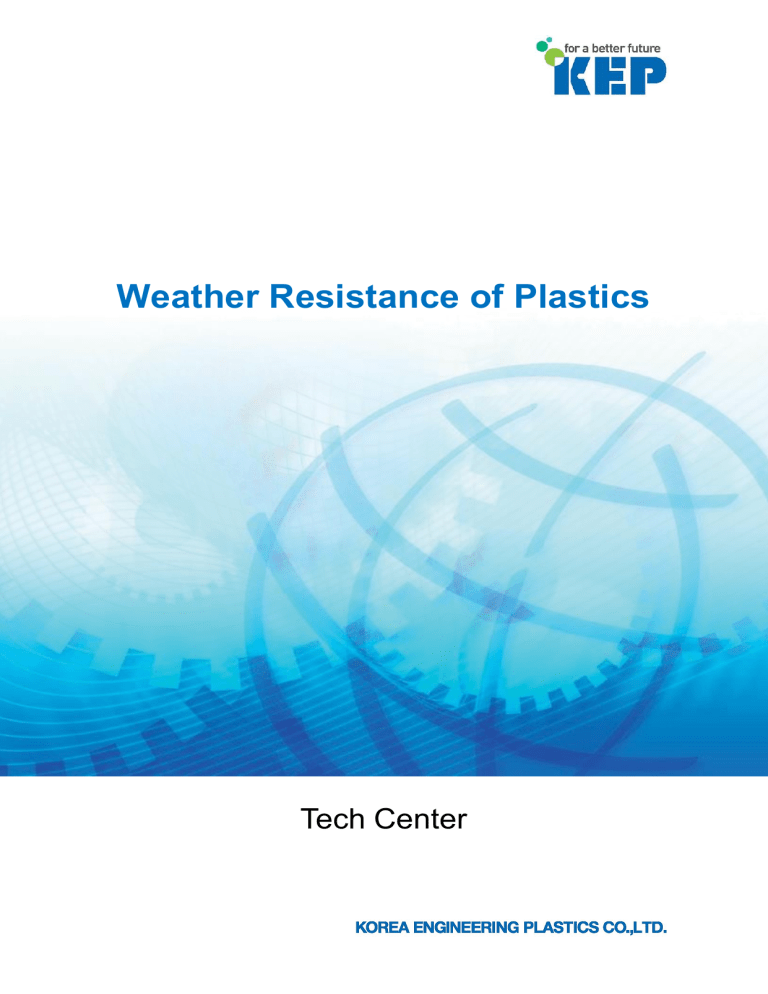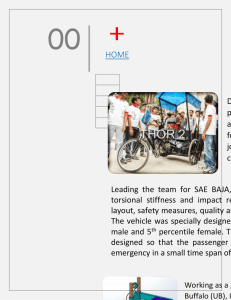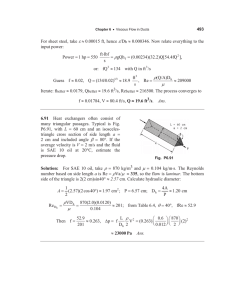
Weather Resistance of Plastics Tech Center www.kepital.com 1. The main factor of plastics degradation in the atmosphere Plastics are damaged based on the duration of exposure under atmospheric environments. The main factors are: light (intensity and amount), water (forms and amount/vapor, liquid, solid), and temperature (pitch). The most important factor is ultraviolet rays of spectrums which consist of solar power. The spectrums which consist of solar power are as below. Solar power reaching the surface of the Earth is from UVB to IRB. UVB is blocked in case of penetrating the glass window. The rate of UV from irradiation of solar power is small, around 6.8% but contains relatively high energy, so it can break chemical bond of plastics. Relative Photon Energy vs Wavelength 4 Relative Photon Energy 3.5 3 2.5 2 1.5 1 250 300 350 400 450 500 550 600 650 700 750 800 nm Photon energy is inversely proportional to wavelength Reference: Data based on CIE Public www.kepital.com 2. What is weather resistance? Weather resistance means the stability to weathering degradation under exposure of atmosphere which classified into interior weathering (which blocks UVB by glass and also has no influence against rainfall) and exterior weathering. A variety of plastics parts exposed to weather require weather resistance properties in accordance with the appropriate environment. In particular, in case of automotive exteriors’ parts require high degrees of weather resistance due to the need of long-term durability. Plastics manufacturers are using light stabilizers to improve weather resistance, particularly having an effect of delaying the degradation of plastics caused by UV. Generally, UV absorbers and HALS (hindered amines light stabilizers) are used, and also apply certain pigments and combinations of pigments in order for effective delay of degradation. To check the improvement of weather resistance of light stabilizers, the results have to be obtained under actual environmental conditions however it takes a long time. For checking weather resistance improvement effects and also for quality assurance, there arises a necessity for test methods that can reduce the test time. 3. Test methods for weather resistance Weather resistance test methods are largely divided into accelerated test methods using an artificial light and outdoor exposure test. (1) Outdoor exposure test Outdoor exposure tests are being conducted in various areas, but generally, the area required for international test methods are both Florida and Arizona. Florida has a standard, constant climate, while Arizona is characterized by high intensity radiation and great diurnal range with a dry climate. A domestic outdoor exposure site is located in Seosan, and there is an advantage to see the effects of sea water and sea breezes. Well-known international outdoor exposure test sites are Juarez, Mexico, Queensland Australia, Cruz Alta, Brazil, and Okinawa Japan. www.kepital.com The automotive industry generally requires an outdoor exposure test over two years, which is used to determine whether the results meet quality standards or not. The total amount of UV exposure during a 2-year outdoor exposure test based on a temperate climate is approximately 500 MJ / ㎡ (300 ~ 400 nm). However, outdoor exposure tests cannot easily ensure reproducibility because actual weather is not constant every year. Furthermore, two years is a long time period in the new product development process, so for truncating long, outdoor exposure test periods, sun tracking devices and condensing units are designed and used. (2) Accelerated test method The accelerated test uses weather resistance testing machines to reduce the test period and implement reproducible environmental conditions compared to outdoor exposure tests. The weathering testing machine is composed of an artificial light source, humidity controller, temperature controlled chamber, spray section and enables repeated testing of the same environmental conditions. The accelerated test method can be classified into four types according to the type of artificial light source as shown below. The initial carbon arc light source is not used much in recent years because of big differences compared to the actual solar light’s spectrum. In general, Xenon Arc light sources similar to the solar spectrum have been used most frequently. The fluorescence method is used to evaluate the effect on the UV with specific method of using only the short wavelength UV. Metalhalide light sources designated to enhance UV intensity several times more to reduce the test period can test UV of 290 ~ 400 (nm) with 100 ~ 3000 (W/㎡) irradiance. (Reference: Ciba technical report) (3) Xenon Arc weathering tester In the case of the accelerated test method, higher irradiance(W/㎡) than nature is introduced to improve acceleration, and to increase the severity of the test, and a method of controlling the UV cutoff to include a lower wavelength than UV reaching the Earth’s surface is applied. Through the combination of other various conditions (temperature, cycle, etc.) it reflects natural conditions and accelerated conditions. The irradiance of natural phenomena is 0.68 W/㎡ @ 340 nm (CIE Publicaion www.kepital.com # 85 Table4) maximum at noon. When irradiance has to be increased, the test must be considered so as not to distort test results due to temperature increases of the specimen surface. The artificial light which generates short wavelengths (UV region) which do not reach the Earth’s surface can be selectively adjusted to the UV region using a filter. The effects of UV cutoff by combination of filter are shown in the graph below. Shorter wavelengths have higher energy so that it can easily break the chemical bonds of the polymer but may cause the phenomenon of unreal atmosphere. Filters with the most similar cutoff position of solar light are CIRA / Soda lime reaching the Earth’s surface at only more than 295 nm wavelength. In the case of an extended UV filter under SAE J2412 and SAE J2527 test method, the cutoff position is 285 nm, the same as a filter consist of the type "S" Borosilicate both inner and outer. SAE J2527 Daylight filter cutoff position is the same as CIRA / Soda lime. Extended UV filter vs. Sunlight Daylight filter vs. Sunlight www.kepital.com (4) Test method for weather resistance The table below is organized between outdoor exposure and accelerated test method and further classified into exterior/interior based on common international standards, and various specifications that have been used, such as car manufacturers’ specifications. Differences exist between each specification, such as a filter and cycle. Classification Interior Material Exterior Complete Vehicle Accelerated Test Outdoor Exposure Test ISO 105-B06 ISO 4892-2 VDA 75202 SAE J1885, SAE J2412 JASO M346 ISO 11341 ISO 4892-2 ISO 11507 ISO 4892-3 VDA 621-430 SAE J1960, SAE J2527 SAE J2020 JASO M351 ISO 3917 ISO 877 ISO2810 SAE J2229 SAE J2230 ASTM G24 DIN 75220 Company specifications SAE J951 Company specifications ISO 877 ISO 2810 SAE J951 SAE J1961 SAE J1976 ASTM G7 ASTM G90 (5) The correlation of outdoor exposure and accelerated test If applying the same UV amount for the derivation of the test period corresponding to the service life required by actual nature, true results cannot be obtained. Because influence of phenomenon not occurring in actual nature due to harsh conditions that facilitate results. Recently in Korea, RS-KRICT009 (Industry Announcement 2014-612) was developed by an alternative of SAE J1960 and SAE J2527 in order to shorten the period of test time and increase the correlation between test methods. This method can shorten the test time of SAE J1960 / J2527 to half. The project for verifying outdoor exposure test methods is underway. Controls RS-KRICT-009 SAE J1960/2527 Cycle Duration time Condition Duration time Condition Dark (minutes) 10 35℃ 60 38℃, spray Spray (minutes) 150 40 W/㎡, 45℃ 20 60 W/㎡, 70℃ Light (minutes) 200 120 W/㎡, 70℃ 100 60 W/㎡, 70 Filter Right-light Quartz/S-Boro 70 158 Required time (days) * radiant exposure value 500 MJ/㎡@300~400 nm (Reference: KRICT project report) • 360 minutes/cycle, 4 cycles/day • 1 week irradiance value: 50 MJ/㎡(tropical), 40 MJ/㎡(temperate), 30 MJ/㎡(subarctic) • 6-week irradiance value: 300 MJ/㎡(tropical), 240 MJ/㎡(temperate), 180 MJ/㎡(subarctic) 6-week test ≒ 1 year (outdoor exposure test) www.kepital.com 4. Product of weather resistance (1) KEPITAL® (POM) KEPITAL Fxx-52, Fxx-52G has improved weather resistance properties for interior applications. It is used in various colors in addition to the basic natural color. The graph below is the result of color variation after the weathering test conducted by an accelerated weathering tester under the SAE J2412 (≒ J1885) method. Color variation is lower than standard grade. 3.0 gray color 2.5 beige color 2.0 1.5 1.0 0.5 0.0 0 Total test time in hours Weather resistance of F20-52 & F30-52 (Interior) 200 400 600 800 1000 Total test경과시간 time in(h)hours Weather resistance of F10-52D (Interior) KEPITAL Fxx-51, Fxx-51U has black-color improved weather resistance properties developed for the purpose of applying to exterior parts. The graph below shows the results of color variation after the weathering test conducted by an accelerated weathering tester under the SAE J2527 (≒ J1960) method. Total test time in hour Weather Resistance of F20-51U (Exterior) www.kepital.com (2) KEPEX® (Polyester) KEPEX 3500SAU is a high toughness, weather resistance PBT grade which exhibits excellent properties in both interior and exterior parts. According to interior conditions of the SAE J2412 (≒ J1885) and exterior conditions of the SAE J2527 (≒ J1960), the test results are as follows: 3500SAU (color: black) Irradiance value Classification Test Method SAE J2527 Exterior (≒ J1960) ΔE* Gray scale 1250 Below 1 More than 4-5 2500 Below 3 More than 4 MJ/㎡ @300~400 nm kJ/㎡ @340nm 145 291 KEPEX 37xxGF has enhanced strength thanks to a variety of contents of glass fiber from PBT / PET resin, and also provides weather resistance properties. 37xxGF ΔE* & Gray scale [SAE J2527(≒ J1960)] 3.0 6.0 2.5 5.0 ΔE* 2.0 4.0 gray scale 1.5 3.0 natural color 1.0 natural color 2.0 black color beige color 0.5 0.0 500 1000 1500 2000 2500 Irradiance value kJ/㎡@340nm 에너지조사량 beige color 1.0 gray color 0 black color 3000 gray color 0.0 0 500 1000 1500 2000 2500 3000 Irradiance value kJ/㎡@340nm 에너지조사량 KEPEX 3930GFU BK is PBT / ASA glass fiber-reinforced weather resistance grade shows ΔE * below 3, tested after 2500 kJ / ㎡ @ 340nm energy irradiation according to the standard for exterior parts SAE J2527 (≒ J1960). www.kepital.com (3) KEPAMID® (Polyamide) KEPAMID 1500SFU & 2300SFU are impact-modified and weather-resistance grades based on polyamide resin, 1500SFU is a PA6-based, and 2300SFU is a PA66-based resin. 1500SFU & 2300SFU Gray-scale [SAE J2412 (≒J1885)] Irradiance value kJ/㎡@340nm 1500 Natural Black Ivory More than 4 More than 3-4 More than 3-4 KEPAMID 1xxxGFU are glass fiber-reinforced weather-resistance PA6 grades, and have weather resistance properties as below: 1350GFU (color: black) Irradiance value Test Method Classification Interior MJ/㎡ @300~400 nm kJ/㎡ @340nm 84 700 SAE J2412 (≒ J1885) ΔE* Gray-scale Below 2 More than 4 1533GFU Gray-scale (SAE J2412 (≒J1885)) Irradiance value kJ/㎡@340nm 1500 Natural Black Gray-scale More than 4 More than 4 More than 3-4 KEPAMID 1340GM8 UBK is GF / MF reinforced PA6 weather resistance grade features for ΔE * below 3, gray-scale 4 after 2500 kJ / ㎡ @ 340nm energy irradiation according to the exterior part weathering test standard SAE J2527 (≒ J1960). 3.0 2.5 2.0 1.5 1.0 black color 0.5 0.0 0 500 1000 1500 2000 Irradiance value kJ/㎡@340nm 에너지조사량 2500 3000 www.kepital.com HQ Mapo-daero 119 (Gongdeok-dong) Hyeoseong Bldg. Mapo-gu, Seoul, Korea Tel 82-2-707-6840 ~ 8, Telefax 82-2-714-9235 KEP Americas 106 North Denton Tap Road Suite 210-202 Coppell, TX 75019, USA Tel +1 888 KEPITAL, Telefax +1 888 537-3291 KEP Europe GmbH Rheingaustrasse 190-196 D-65203 Wiesbaden, Germany Tel +49 (0)611 962-7381, Telefax +49 (0)611 962-9132 KEP China A1905, HongQiao Nanfeng Plaza, 100 Zunyi Road, Shanghai, China Tel +86 21 6237-1972, Telefax +86 21 6237-1803 Disclaimer: The information contained in this data sheet is based on our current knowledge and experience, so it may change as new knowledge and experience becomes available. This information is based on only abovementioned product produced in Korea Engineering Plastics Co., Ltd. (“KEP”) through relevant test methods and conditions and doesn’t relate to any products made of this product with the inclusion of other additives, such as processing aids or colorants. This information should not be construed as a promise or guarantee of specific properties of this product described or its suitability for a particular application, so users make their own determination as to its suitability to their purposes prior to use this product. It is the sole responsibility of the users to investigate whether any existing patents are infringed by the use of this product. This product is not intended for use in medical and dental implants and users should meet all safety and health standards. KEP makes no warranty and assumes no liability in connection with any use of this information.

